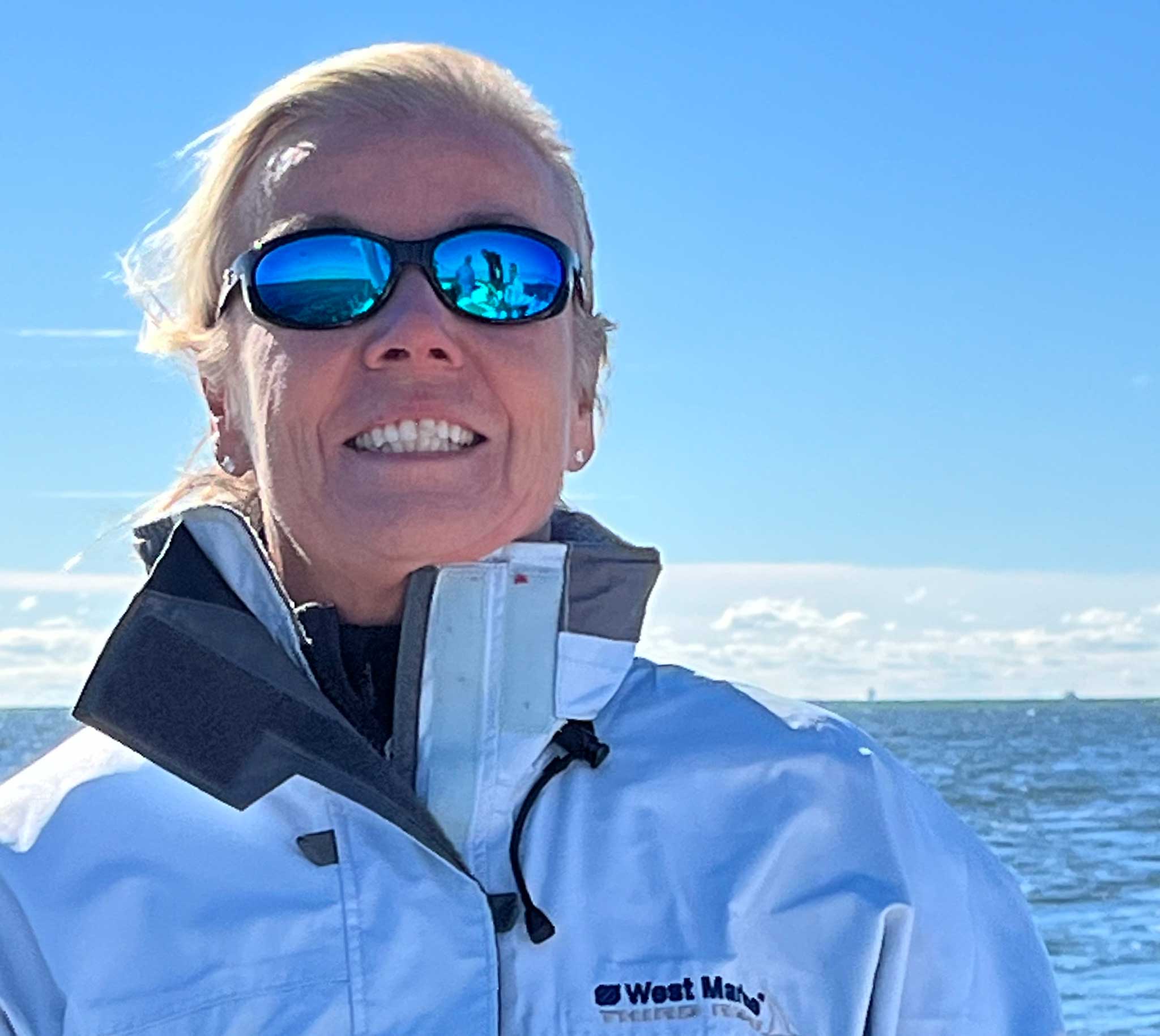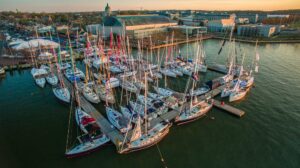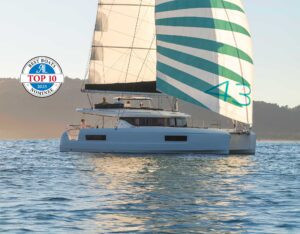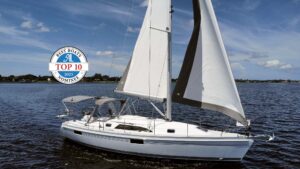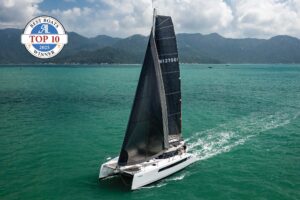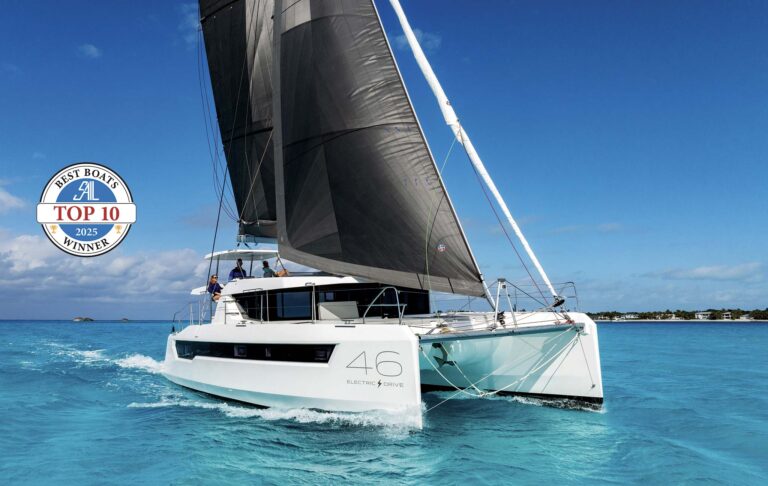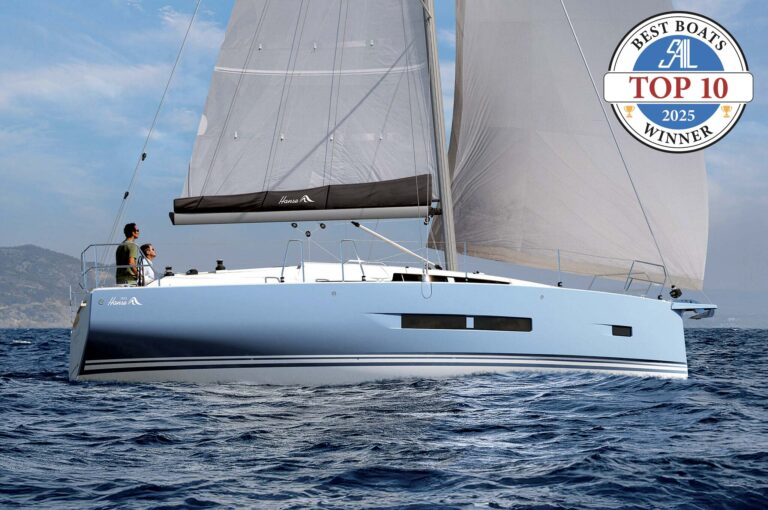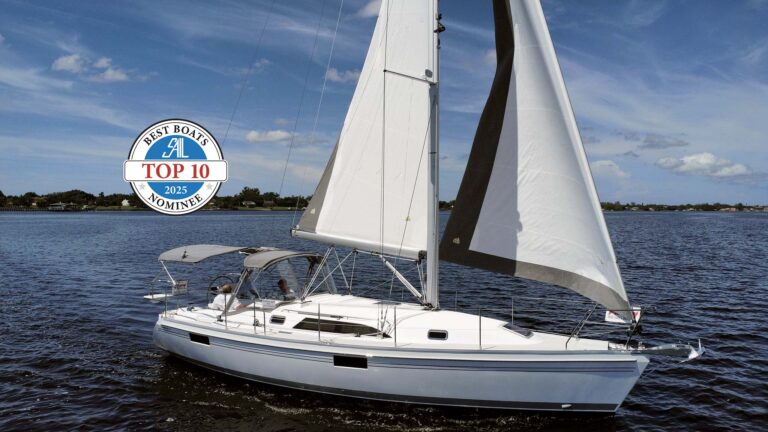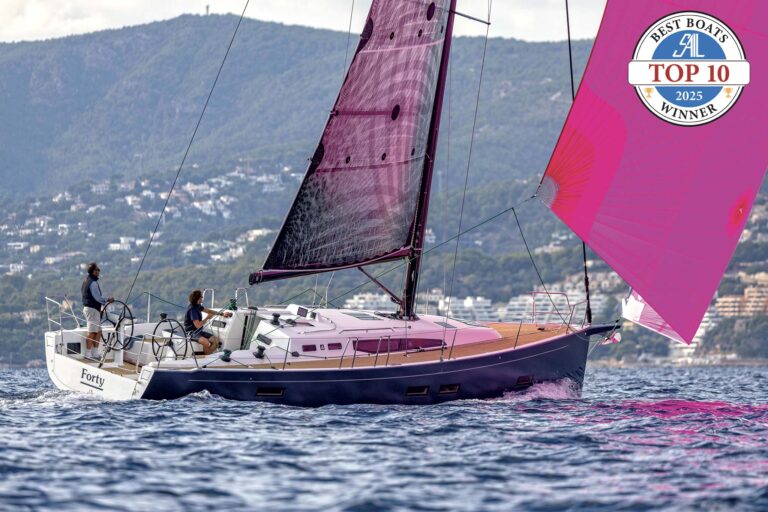
X-Yachts, the Danish builder of high-quality, performance-oriented sailboats, recently introduced a new X line that is positioned somewhere between its Xp racing models and its Xc cruisers. The 42ft X4 (also called the X43 in some company literature) follows in the footsteps of the X6 launched last year and should find a ready market among those who aren’t quite up to the challenge of an Xp, but would still like something with a little more pep than a classically styled Xc. The result is a mashup that I found to be more than the sum of its parts, and that is an absolute joy to sail.
Design & Construction
With its vacuum-infused, baked epoxy construction and advanced M-foam coring (more expensive but stiffer), the X4’s basic structure is only 8 percent heavier than its performance-line counterpart, while still including an X-Yachts trademark steel hull grid to help spread keel loads and stiffen the hull. Because the build is lighter, the boat can incorporate larger fuel and water tanks, add more battery capacity and carry more cruising equipment without unduly compromising performance.
Designed by longtime X-Yachts mainstay Neils Jeppesen, the X4 is also fitted with a super-efficient encapsulated keel that is available in three depths, depending on the nature of your home waters and sailing style, from 6ft 1in to 8ft 3in, with either a T- or L-shaped bulb.
The overall look is long, lean and purposeful—belying the substantial volume belowdecks that sets it apart from its Xp brethren—with the blunt ends complemented by a low, elegantly sculpted cabintrunk featuring equally long, elegant portlights/windows. This boat will be a head-turner in any harbor or marina.
On Deck
Topside, the X4 is all about choices. The standard fractional rig includes a keel-stepped, aluminum Seldén mast with double, slightly aft-swept spreaders and discontinuous rod rigging. (A carbon mast is an option.) Spectra halyards are led aft via belowdeck channels to Spinlock X7S rope clutches in the cockpit, and there is the choice of a manual or hydraulic backstay adjuster.
Stainless steel wheels with leather covers come standard, but our test boat sported the optional flashy Carbonautica composite wheels that feel so good to the hand. The standard cockpit table is fixed and has room for a plotter and instrument pods. A removable table is also available to facilitate easier crewed racing. (With the removable table, twin 12in B&G plotters can be mounted atop the angled pedestals; Raymarine navigation electronics are also available.) Another option includes topping the pedestals with compasses and grab rails.
Farther aft, you can choose between an open transom or one that drops down to form a swim platform. Forward, the options at the sharp end include one of three bowsprit configurations: a standard composite cowl with an integrated anchor fitting; an extended carbon sprit with an anchor roller; or a lightweight carbon sprit with no roller. More on-deck choices include a fixed windshield, electric winches and teak side decks to complement the teak cockpit sole.
The double-ended mainsheet is led aft to a pair of self-tailing Harken winches (four other winches are forward for handling halyards and headsails). The traveler bisects the cockpit sole into which it is recessed, and the slightly-overlapping genoa flies from a Furlex belowdeck furler. Sightlines from the helm and the side decks are equally clear, making the boat a joy to handle, whether it’s racing around the buoys, or going for a cruise or a daysail.

Accommodations
Danish design is renowned for its modern style, and the X4 is chock full of it. The standard finish is T-Tech engineered wood, which is a darker, almost teak color, while the optional O-Tech joinery is lighter, like much of the home furniture for which Denmark is rightly famous. The overall aesthetic is clean and minimalist, with 11 fixed portlights and 12 opening Lewmar hatches bringing in lots of air and light. Combined with the white Corian counters, the entire interior seems to almost glow. A Fusion stereo with Bose speakers adds high-quality tunes to this already pleasant ambiance.
Four layout options are available, providing two or three cabins and one or two heads. The master cabin forward comes with an island berth and either an ensuite wet head or a bureau to port. In the two-cabin layouts, the central head is pushed well aft and is full-sized, with a larger showering space (not quite a stall). This also makes room for a dedicated, forward-facing navigation station. With three cabins, this same head is slightly more forward and a bit truncated. In this same layout, the nav station becomes aft-facing, sharing the seat with the starboard straight settee.
In all cases, the L-shaped galley is to port at the foot of the companionway. Twin sinks, a gimbaled Eno stove/oven combination and Isotherm top-loading refrigeration will help the chef turn out gourmet meals for the crew. Another optional, under-counter front-loading Isotherm fridge can be added. Drawers and lockers are plentiful, so it will be easy to stow kitchen gadgets and provisions. The U-shaped settee in the saloon wraps around a table that folds out to join the port settee, so six can have dinner without bumping elbows.
My personal favorite among these various configurations is the one with two cabins, the large single head aft and the aft-facing nav station with the nicely integrated bookshelf above. To me, that seems to be the best use of space for a couple with a child or occasional guests.
Under Sail
Our test boat was hull #4, and we lucked out as it was nice and breezy on Chesapeake Bay the evening of my sail. Unfortunately, enthralled by watching the more than 1,000ft2 of sail overhead, I quickly found the shallows, and we slowly slid to a stop in the mud. No worries, though. X-Yachts are built to withstand far more serious groundings than that, and we were soon underway again.
With 10-12 knots of steady breeze and the 106 percent genoa working in tandem with the large, powerful main, we clicked off 7.9 knots sailing at a 36-38 degree apparent wind angle (AWA). Yes, the X4 will point that high and not stall. With an asymmetrical spinnaker flying, we easily cruised along at 8.4 knots at an AWA of 120 degrees.
The helm is the lightest I’ve felt in quite a while, and the boat is supremely responsive, with a large, high-aspect, semi-balanced rudder set well aft, perfectly complementing the boat’s high-aspect keel. Any racer interested in retaining a performance edge while at the same time wanting to share his or her passion with family members craving a little more comfort, should take a long, hard look at the X4.
Under Power
With the throttle wide-open we motored at 8.4 knots at 3,200 rpm, although a better cruising speed is 7.0 knots at 2,000 rpm. Auxiliary power is supplied by a Yanmar common-rail 45hp diesel with a saildrive that manages the roughly 19,500lb displacement with ease.
Conclusion
It’s too early to tell whether there is truly room between the Xc and Xp lines for this newest type of X-Yacht. Unfortunately, with its good performance and plethora of amenities, I could easily see it muscling one or the other line aside. That said, given the quality of both this boat and the entire X-Yachts fleet, here’s hoping they all figure out a way to peacefully coexist, while at the same time drawing in any number of new buyers looking for the best of all possible worlds.
What do the ratios mean? Visit sailmagazine.com/ratios

July 2017
SPECIFICATIONS:
- LOA 42ft 4in
- LWL 37ft 2in
- Beam 13ft
- Draft 6ft 1in (shoal); 7ft 3in (std); 8ft 3in (deep)
- Displacement 19,511lb
- Engine Yanmar 45hp
- Fuel (GAL) 53
- Water (GAL) 90
- Sail Area 1,044ft2 (106% genoa and main)
- Ratio Ballast Ratio 43 SA/D Ratio 23 D/L Ratio 171
- Designer Niels Jeppesen
- Builder X-Yachts, Denmark
- U.S. Distributor Rodgers Yacht Sales, Mystic, CT
- Ballast 8,378lb

